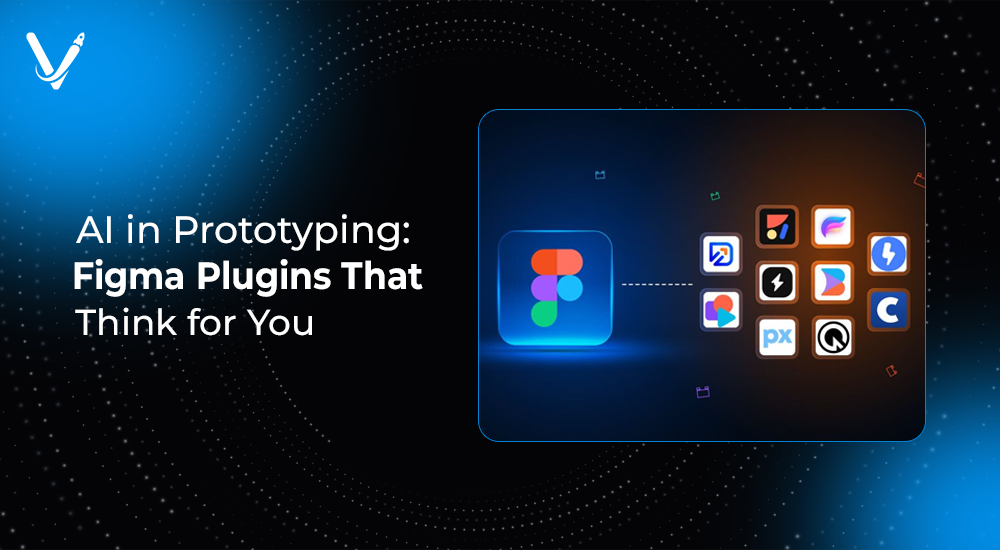AI in Prototyping: Figma Plugins That Think for You


- Jun 13, 2025



Design is no longer just about creativity and aesthetic choices. It’s about speed, efficiency, and collaboration, especially when building digital products in fast-paced environments. In today’s tech-driven world, the pressure to design faster and iterate smarter has led to a new ally in the designer’s toolkit: Artificial Intelligence (AI).
Figma, the go-to platform for UI/UX design, has embraced this evolution by opening its plugin ecosystem to AI-powered tools. These plugins don’t just assist with minor tweaks—they think, generate, suggest, and even redesign entire components based on intent. This article dives deep into how AI is transforming prototyping within Figma, the leading tools driving this change, and how you can leverage them to supercharge your workflow.
The prototyping phase bridges ideation and development. Traditionally, this step demanded hours of manual effort—designing screens, maintaining consistency, revising flows, and testing usability. AI intervenes here by:
This shift empowers designers to focus on solving problems and telling better user stories, while AI handles the groundwork.
Figma’s architecture is inherently collaborative and plugin-friendly, making it the perfect sandbox for AI experimentation. Here’s what makes Figma stand out:
With these strengths, Figma becomes not just a design tool—but a smart design assistant.
Here are some of the most impactful Figma plugins that are transforming how designers prototype and iterate.
Genius integrates directly with ChatGPT to generate interface designs from natural language prompts. Designers can write “Create a login screen for a mobile banking app,” and Genius will produce a layout with buttons, inputs, and branding considerations.
Key Benefits:
Use Case: A startup looking to prototype a new app within a day can get its first iteration in minutes using Genius, allowing more time for feedback and iteration.
Words are just as important as visuals. Magician uses AI to generate copy for buttons, tooltips, notifications, and headers. It even suggests tone options like professional, fun, or instructional.
Key Benefits:
Use Case: A team designing a multilingual SaaS dashboard can get AI-suggested microcopy in multiple languages—without relying on separate translation tools.
Automator allows you to build logic-based workflows in Figma. Think of it like Zapier but for your design files. You can automate renaming layers, resizing components, or linking screens based on rules.
Key Benefits:
Use Case: An agency handling 50+ artboards for an e-commerce app can standardize interactions and layout changes across all views in seconds.
Instead of manually populating profile pictures or user personas, UI Faces and Avatar AI generate realistic avatars based on demographic and style inputs.
Key Benefits:
Use Case: For testing user flows in social apps or dating platforms, realistic personas boost the empathy and engagement of stakeholders.
Designs.ai offers pre-built templates based on your brand tone and project goal. It generates design themes, layout suggestions, and even brand kits automatically.
Key Benefits:
Use Case: A bootstrapped founder can skip hiring a designer and instantly get a brand-consistent layout for a pitch deck, web app, or mobile MVP.
AI enables converting written product ideas into tangible wireframes and clickable prototypes. This drastically reduces the time between brainstorm and testable mockup.
Through pattern recognition and machine learning, AI ensures consistent usage of spacing, color schemes, and components—avoiding human oversight.
AI can simulate user journeys and predict friction points, making usability testing quicker and more insightful.
AI plugins often highlight accessibility issues in real-time, including color contrast, font size legibility, and layout flow, making it easier to design inclusively.
Startup: FinDash, a finance tracking app
Challenge: Needed to prototype and validate 10+ mobile screens within 48 hours for investor presentation
Solution:
Outcome:
Finished full clickable prototype in less than 12 hours, tested with 20 users, iterated twice, and presented to investors the next day. The MVP was built based on the validated prototype, reducing development time by 3 weeks.
As AI models grow more context-aware and multimodal (understanding text, visuals, and interactions), we can expect:
AI won’t replace designers—but it will make the best designers 10x more efficient.
The era of intelligent design is here—and it’s redefining how we approach UX prototyping. With the power of AI-driven Figma plugins, what used to take days can now be achieved in minutes. These tools don’t just speed up the process—they also encourage experimentation, reduce cognitive load, and allow more time for what truly matters: designing experiences users love.
Whether you're a startup founder, solo designer, or part of an enterprise team, the integration of AI in your design process is no longer optional—it’s a competitive advantage.
Ready to build smarter, faster, and better?
Let Vasundhara Infotech help you integrate AI into your product design and development cycle. Contact us today to kickstart your next prototype with intelligent design tools.
Copyright © 2025 Vasundhara Infotech. All Rights Reserved.